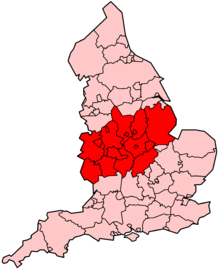The Midlands

The Midlands is an area comprising central England that broadly corresponds to the early medieval Kingdom of Mercia. It borders Southern England, Northern England, East Anglia and Wales. Its largest city is Birmingham, and it was an important location for the Industrial Revolution of the 18th and 19th centuries. The greater part of the area is now administered as the Government Office Regions of the West Midlands and East Midlands, though parts of the traditional Midlands are also in surrounding regions, namely Bedfordshire, Cambridgeshire and Peterborough (East of England), Buckinghamshire and Oxfordshire (South East), Gloucestershire (South West) and Northern Lincolnshire and Sheffield (Yorkshire and the Humber).
Extent of the Midlands
The Midlands does not correspond to any current administrative area, and there is therefore no strict definition. However, it is generally considered to include the counties of Derbyshire, Gloucestershire, Herefordshire, Leicestershire, Northamptonshire, Nottinghamshire, Oxfordshire, Rutland, Shropshire, Staffordshire, Warwickshire, the West Midlands and Worcestershire. Lincolnshire is considered by some part of the Midlands but generally excluded, on account of its extensive coastline. The 1911 Encyclopædia Britannica describes Gloucestershire as "west midland", Bedfordshire as "south midland", and Huntingdonshire as "east midland" counties respectively. Sheffield is included as it is considered the 'capital' of the north Midlands

With more restricted boundaries than the traditional area known as the Midlands, two modern Government Office Regions together represent the latter: West Midlands and East Midlands. These are also constituencies of the European Parliament.
The West Midlands comprises the shire counties of (1) Staffordshire, (2) Warwickshire and (3) Worcestershire (with their respective districts), the unitary counties of (4) Herefordshire and (5) Shropshire, the metropolitan boroughs of (6) Birmingham, (7) Coventry, (8) Dudley, (9) Sandwell, (10) Solihull, (11) Walsall and (12) Wolverhampton, and the unitary boroughs of (13) Stoke-on-Trent and (14) Telford and Wrekin. The East Midlands comprises the shire counties of (15) Derbyshire, (16) Leicestershire, (17) Lincolnshire, (18) Northamptonshire and (19) Nottinghamshire (with their respective districts) and the unitary county of (20) Rutland. The two regions have a combined population of 9,439,516 (2001 census), and an area of 11,053 sq mi (28,631 km²). The loose;y defined North Midlands is centred on Sheffield
The largest Midlands conurbation, which includes the cities of Birmingham and Wolverhampton, is approximately covered by the metropolitan county (which also includes the city of Coventry) of the West Midlands. Parts of the East Midlands are also densely populated, particularly the triangle formed by the cities of Nottingham, Leicester and Derby, which also includes sizeable towns such as Loughborough and the Long Eaton–Beeston–Stapleford subconurbation.
Various part of the Midlands (particularly Warwickshire and Leicestershire) are somewhat poetically referred to as the Heart of England, especially in tourist literature.
The various areas of the Midlands have their own distinctive character, giving rise to a high number of local history and industrial heritage groups. Nottingham played a notable part in the English Civil War, which is commemorated in a number of place names (Parliament Terrace, Parliament Street, Standard Hill). Areas such as Derbyshire's Amber Valley and Erewash combine attractive countryside with industrial heritage and are home to historic canals and sites associated with the mining industry.
Cities and notable towns
- Birmingham, Boston, Burton upon Trent, Bromsgrove
- Cannock, Chesterfield, Corby, Coventry
- Derby, Dudley, Evesham,
- Grantham,
- Halesowen, Hereford,
- Kettering, Kidderminster, Kingswinford
- Leamington Spa, Leicester, Lichfield, Lincoln, Loughborough,
- Malvern, Mansfield
- Newark-on-Trent, Newcastle-under-Lyme, Northampton, Nottingham, Nuneaton,
- Oakham,
- Redditch, Rugby, Rushden, Rugeley,
- Sheffield, Smethwick, Solihull, Stafford, Stoke-on-Trent, Stourbridge, Stratford-upon-Avon, Sutton Coldfield,
- Tamworth, Telford,
- Walsall, Warwick, Wellingborough, West Bromwich, Wolverhampton, Worcester, Worksop.
Sport
Football
| Club | League | City/Town | Stadium | Capacity |
|---|---|---|---|---|
| Aston Villa F.C. | Premier League | Birmingham | Villa Park | 42,788 |
| Stoke City F.C. | Premier League | Stoke-on-Trent | Britannia Stadium | 28,384 |
| West Bromwich Albion F.C. | Premier League | West Bromwich | The Hawthorns | 26,500 |
| Birmingham City F.C. | Football League Championship | Birmingham | St Andrew's | 30,079 |
| Derby County F.C. | Football League Championship | Derby | Pride Park Stadium | 33,597 |
| Leicester City F.C. | Football League Championship | Leicester | Walkers Stadium | 32,500 |
| Nottingham Forest F.C. | Football League Championship | Nottingham | City Ground | 30,576 |
| Coventry City F.C. | Football League One | Coventry | Ricoh Arena | 32,609 |
| Notts County F.C. | Football League One | Nottingham | Meadow Lane | 21,300 |
| Shrewsbury Town F.C. | Football League One | Shrewsbury | Prostar Stadium | 9,875 |
| Walsall F.C. | Football League One | Walsall | Bescot Stadium | 11,300 |
| Wolverhampton Wanderers F.C. | Football League One | Wolverhampton | Molineux Stadium | 30,852 |
| Burton Albion F.C. | Football League Two | Burton Upon Trent | Pirelli Stadium | 6,912 |
| Chesterfield F.C. | Football League Two | Chesterfield | Proact Stadium | 10,600 |
| Northampton Town F.C. | Football League Two | Northampton | Sixfields Stadium | 7,653 |
| Mansfield Town F.C. | Football League Two | Mansfield | Field Mill | 10,000 |
| Port Vale | Football League Two | Stoke-on-Trent | Vale Park | 19,052 |
Rugby union
| Club | League | City/Town | Stadium | Capacity |
|---|---|---|---|---|
| Leicester Tigers | Aviva Premiership | Leicester | Welford Road | 24,000 |
| Northampton Saints | Aviva Premiership | Northampton | Franklin's Gardens | 13,600 |
| Worcester Warriors | Aviva Premiership | Worcester | Sixways Stadium | 12,068 |
| Moseley | RFU Championship | Birmingham | Billesley Common | 3,000 |
| Nottingham | RFU Championship | Nottingham | Meadow Lane | 19,588 |
External links
Coordinates: 52°42′N 1°30′W / 52.7°N 1.5°W